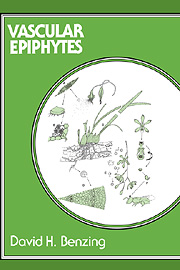3 - Water balance
Published online by Cambridge University Press: 29 October 2009
Summary
Aspects of foliage reveal the fact that stress, particularly drought, is a powerful selective force on plants anchored in tree crowns. Whereas phorophytes are usually characterized by mesomorphic leaves and C3 photosynthesis, their epiphytes tend to xeromorphism and unusual mechanisms for procuring, as well as greater capacity for storing, water. Therefore, if accommodations to aridity can be identified, so will many of the epiphytes' most distinguishing features. In this chapter, that challenge is met by first laying some groundwork and then examining the nature of water balance mechanisms and their influence on overall epiphyte biology.
Water use and conservation: defense against drought
All land plants must expend water in order to create biomass. As stomata open for CO2 influx, water vapor exits at a much higher rate. Xerophytic forms manage this unavoidable trade-off with suprising success: Their transpiration ratios (TRs) are in the neighborhood of 100:1, and exceptional performers do considerably better (Table 3.1). But water economy always has its price; productivity is slowed as leaf conductance falls – the lower the TR, the slower it is. In contrast, species native to humid habitats or those arid-land dwellers whose active phase coincides with the rainy season expend as much as 1000 g of water for each gram of dry matter they create. These drought-sensitive taxa serve notice that parsimonious water use is not always the best mechanism and can be decidedly disadvantageous when moisture is plentiful.
- Type
- Chapter
- Information
- Vascular EpiphytesGeneral Biology and Related Biota, pp. 80 - 111Publisher: Cambridge University PressPrint publication year: 1990



